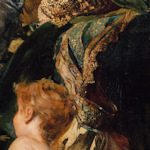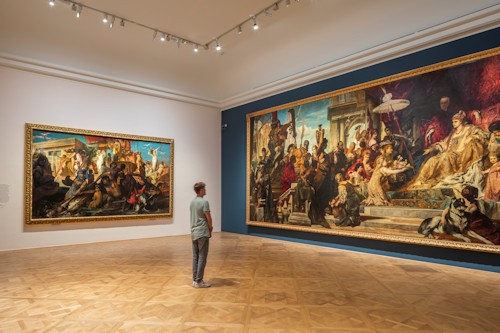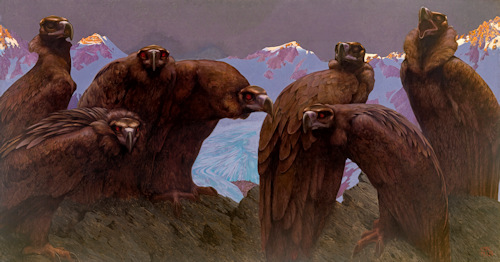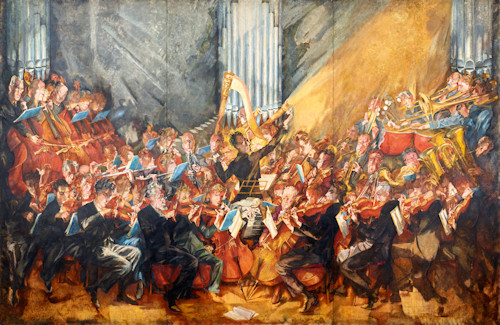
“That’s not a painting. THAT’S a painting.” As Crocodile Dundee might have said. The Colossal exhibition at Lower Belvedere makes space for the kind of large format magnificence that rarely finds its way into galleries.
- Around 19 works
- …from the Baroque to the contemporary
- Largest is over 10m long
- Makart, Oppenheimer, Nitsch, and more
- Large format offers a different level of viewing experience
- Runs June 22 – August 27, 2023
- See also:
- Overview of Lower Belvedere
- Art exhibitions in Vienna
Painting on a grand scale

(Exhibition view “Colossal. Painting on a Grand Scale”; press photo courtesy of and © Johannes Stoll / Belvedere, Wien)
I live in constant awe of those who can create art.
The respect goes up to 11 for those working in miniature (check the 16th-century rosary pendant in the Kunstkammer of the Kunsthistorisches Museum, for example).
And the dial stays at 11 for those working on a grander scale, which places its own special demands on the artist.
Imagine Michelangelo on his back beneath the ceiling of the Sistine chapel. Grumbling as another drop of paint hits his furrowed brow. How? That level of genius remains beyond my comprehension.
Giant works rarely make their way into art exhibitions for obvious logistical reasons. Pulling a painting from the archive presents a particular challenge when said painting is longer than your average SUV.
And then you have the simple issue of wall space.
So Lower Belvedere’s Colossal exhibition offers a rare opportunity: a chance to see some rather powerful large-format paintings from the Belvedere collection.

(Tina Blau, Spring in the Prater, 1882; press photo courtesy of and © Johannes Stoll / Belvedere, Wien)
Around nineteen works feature, ranging from Baroque era religious scenes to contemporary art.
The exhibition offers far more than simply a collection of those pieces that rarely emerge into the gallery light.
First, these works really need to be seen live to truly appreciate them. Instagram does not cut it on this occasion.
Take Karl Huck’s 1908 Awakening (Eagles), for example. Not viewed in public since 1926, it has you turning your head and shifting your eyes from one piercing red-eyed avian gaze to the next. Not something to hang in the kids bedroom.

(Karl Huck, Awakening (Eagles), 1908; press photo courtesy of and © Johannes Stoll / Belvedere, Wien)
Second, we gain insights into the provenance of such works and the particular challenges involved in their creation (and restoration).
Be sure to read the quote by Herbert Brandl next to his 1997 Untitled, especially if you write (the parallels between creating a large-format painting and a novel are remarkable).
Third, the large format opens another level of appreciation of the artist’s work, most notably when viewing the busy paintings that allow an immersion not always possible with standard formats.
You can spend a while just examining the atmosphere and movement expressed all over Oppenheimer’s Die Philharmoniker or the representation of fabric in Hans Makart’s 1872/1873 Venice pays tribute to Caterina Cornaro.

(Max Oppenheimer, The Philharmonic, 1926-1952; Artothek des Bundes, on permanent loan to the Belvedere, Vienna; press photo courtesy of and © Johannes Stoll / Belvedere, Wien)
Makart gets an entire room to his monumental history paintings, with the Cornaro work over 10m long and covering an area of around 42.4m2 (equivalent to several full-sized snooker tables).
Other artist names from the past include Carl Moll, Tina Blau, and Albin Egger-Lienz.
On the modern day front, abstract approaches in large format gain a stark power. Enjoy works by some modern Austrian greats like the aforementioned Herbert Brandl, Jakob Gasteiger, Hubert Scheibl and Hermann Nitsch. The latter’s 1983 work comes closest to Makart-like dimensions at almost 6m in length.
Dates, tickets & tips
Browse the large format paintings from June 22nd to August 27th, 2023. A valid entrance ticket for or from Lower Belvedere includes the exhibition.
By definition, you won’t find many works of similar size elsewhere in Vienna. Though the picture galleries in the Kunsthistorisches Museum (KHM) have a few by the Old Masters.
Sadly, museums don’t let you sort their digital database by physical dimensions. But two paintings at the KHM stick in my mind:
- Caravaggio’s Madonna of the Rosary (almost 10m2)
- The Miracles of St. Francis Xavier by Peter Paul Rubens (which comes in at over 21m2)
Another solid option is the Beethoven frieze by Gustav Klimt over at the Secession building. So long even Makart would be jealous. (Don’t forget to pop up to Upper Belvedere for more by Klimt)
And, if you’re here in summer, the façade of the Ringturm office tower has a specially commissioned contemporary artwork whose size would make Makart’s head melt.
How to get to Lower Belvedere
Just follow the tips on the Belvedere directions page.
Address: Rennweg 6, 1030 Vienna
(Article icon courtesy of the Met Museum)